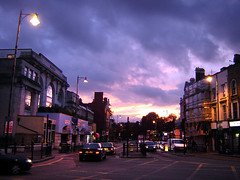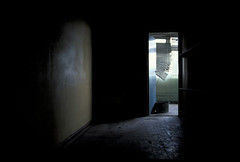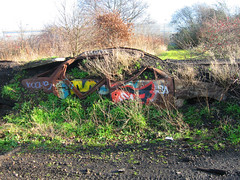I recently got an email from Jamie Smith, formerly known as grime producer Dr Venom from the True Tiger Camp, now known as part of indie/grime band Hadouken, who Logan amusingly suggested could suck his ballbag recently. Jamie asked me if I'd answer some questions on the interaction between technology and grime/dubstep, and as everytime I answer a query like this, it detracts from my blog, I thought I'd share my answers here.
Then today, I get a call from the NME asking about a dubstep primer they're running, which has a Hadouken boxout as part of it. Apparently indie clubs are having "a dubstep hour". Eeek. Ah well, my primary gripe with the NME (and all the powerful rock press) is that they're so narrowly monocultural, so I won't complain when indie clubs embrace the bass.
TECHNOLOGY AND GRIME
Jamie: What effect is Web 2.0 having on Grime and Dubstep? Is the distribution of content having a positive effect or is the piracy starving finances or killing off the record shop as an institution?
Martin: “By its very nature, “Web 2.0” is beneficial to niche, underground genres like dubstep and grime. Instead of relying on the blessing, or lack thereof, of ‘head content’ providers, walled garden portals trying to attract mass ABC1 advertiser audiences by pushing out mass market content, Web 2.0 allows the proliferation of niche ‘tail content’ to diverse, ill-defined and disparate audiences, who’s net sum might be significant in size yet their total numbers in any one location or demographic might be small.”
“Web 2.0 sites like Blogger, Wikipedia, MySpace, Flickr and Del.icio.us allow fans to not just gain information (the traditional Web 1.0 model) but contribute information back to the community or scene they’re interested in. You only have to look at how grime has adopted MySpace (now UK broadband penetration has dropped costs to such mass market affordable levels) to see how much a role it plays.”
“Personally I can’t see how distribution of (written) content can be a bad thing for scenes like these, where the threshold to get in to traditional media (TV, Newspapers and magazines – in order of descending threshold size) are sufficiently high as to act as a barrier to growth and sustainability of scenes.”
“As for the distribution of digital music content, well this isn’t a “Web 2.0” phenomenon per se but yes, as iPods have become ubiquitous, clearly digital music sales and piracy are closing down physical vinyl stores.”
Advances in technology and web development seem to be wiping out the need for a record label middle man, as case of JME seems to be proving. Do you feel that this direct release of content is the way forward for Grime Acts?
“What grime needs to do is not tied to any one technology per se, it’s about infrastructure because it’s lost its moment with the major labels – people who would do all the industry work for them. Whether it sells traditional vinyl or builds the next iTunes from scratch, the grime scene needs to learn to work together, start legal businesses, sell to a wider audience, get good distribution links and understand proper promotion. This isn’t Web 2.0 this is Music Industry 101, whether you use MySpace or Radio Caroline to achieve your aims.”
Advances in technology have given birth to such concepts as the Grime DVD. Would you say embracing new formats such as this is detrimental to the future of Grime and the underground?
“Embracing technologies that widens your current fan base and appeal can never be detrimental to a scene’s growth. Everyone has a Playstation in their house that will play a DVD, but how many bother with record decks these days? Grime DVDs were clearly the right move when traditional mainstream TV or DVD manufacturers wouldn’t touch them with a barge pole.”
What effect would you say the dominance of the mixtape format is having on the Grime scene, in terms of promotion, finances and nurturing talent?
“Firstly it’s killing vinyl sales, which if you’re passionate about the format, is a sad loss, but at least CD mixtapes can get to the widest possible audience, which is great for promotion. Financially they make much more sense than vinyl, because you recoup your manufacturing costs after about 15% not 80% sales (approximate figures). However you have to consider the studio costs of vocalling 20 CD tracks not four or two vinyl ones. I still think they’re lowering the entry barriers though, because they can be made cheaply. This has a short term detrimental effect on quality control – not just the quality of the artist but the quality of the tracks on a given artist’s CD - but a positive effect on long term size and health of the scene as new players take new risks.”
Do you think that the aggressive nature of Grime music exacerbates, or merely reflects the violence on the streets of deprived areas?
“I think in a list of factors of causes of street violence, the music is very low down, below poverty, lack of education, lack of job opportunities, lack of positive male role models, the increase in divorce rates, access to cheap illegal fire arms, access to drugs, the inequalities of the UK class system and ill informed life choices by the community itself. I don’t see people who perpetuate street violence as completely helpless victims, because they should have some responsibility for their actions despite the hand life has dealt them but equally I see anyone from that background who chooses to make music and not focus on violence as someone who has made a positive choice in life.”
Why has the mainstream music industry been reluctant to pick up or appropriate Grime acts? Do you think this is something we are still yet to see?
“The mainstream music industry has taken some acts on (Lethal B, Roll Deep, Kano) while other acts have gained substantial independent funding (Dizzee Rascal, Newham Generals), but largely there has been a dysfunctional relationship between grime and the UK majors. The UK majors know how to make aggressive MCs like 50 Cent sell in the UK, so they can’t argue that aggressive music doesn’t sell, yet they can’t seem to sell grime to the UK. Equally a lot of MCs have spurned the chance to work with the majors by acting too “road” (unreliability and an inability to take orders scares off majors) and acting like they’re “owed” a big deal for the work they’ve done in the past (which is largely invisible and therefore worthless to a major label audience), rather than having the mindset that they get a major deal and then “earn” back the money invested in them through mainstream sales.”
Wednesday, February 28, 2007
Sunday, February 25, 2007
Mega's Corp
As if by magic, So Solid reappeared this week, on Logan’s Kiss show, causing what felt like a strange temporal aberration, where past and present were neatly aligned for comparison.
It’s been six years since So Solid exploded onto the UK mainstream, during which grime – a genre which they must take some credit for laying the foundations – has exploded and somewhat contracted. What made Megaman’s interview on Logan’s show so mesmerising was that he talked like nothing had changed, like Wiley and Dizzee hadn't unleashed a whole new, uniquely UK sound.
I interviewed a whole bunch of So Solid for The Face as they collected trophies with Ms Dynamite at the ill-fated UK Garage awards in Brixton. But there are few people I’ve encountered in urban music who come across as confidently as Megaman did on air.
The certainty in his voice, in his sense of purpose, the scope So Solid’s original ambition, was staggering, as he ran off lists of seven figure label deals, six figure video budgets, massive album and publishing deals that So Solid had entered into. How things have changed in six years.
According to Megaman, So Solid’s first four videos cost £68k, £168k, £256k and £368k respectively. Their two album deals were £500k each, with Lisa Maffia and Asher D’s costing £350k each, and Romeo and JD £210k apiece. Megaman’s label deal with Independente was worth £1m, where he signed affiliates Cream Cartel. That’s £3.98m spent by the labels on So Solid (not including the EMI publishing deal). Cream Cartel didn’t release more than a single.
You just don’t hear record companies talking like that anymore, with their cheque books anyway. No UK urban acts gets £300,000 for their whole deal, let alone for their video these days – as Megaman pointed out. In fact, people aren’t getting deals at all.
But you also don’t hear MCs talking like that anymore. Mega’s talk is strictly business. Ghetto – to pick but one of many MC – is strickly war. When grime MCs talk about “making moves” they’re talking about jumping in the Clio and “rolling on a man,” not heading down to Companies House to register their business.
Wiley, like many of the grime MCs, regularly talks about paper chasing, but apart from the Roll Deep/Relentless deal, he seems to be living day to day, or mix CD to UKrecordshop.com in the car boot, to be precise. People praise JME because he’s put out more than one underground mix CD a month – and that’s supposed to be progress for the grime industry. Bashy laughed on Logan’s show the other week how Scorcher was simply dashing the CDs into the back of his car without even boxing them. He also said that he simply had to stop MCing before “Chupa Chups" because the music wasn’t funding it. And while I don’t know what Bashy did in his down time, if many other MCs bars are to be believed a lot of their MC careers are being funded by drug money – hardly a sustainable music industry in action, tragically.
Contrast this with Mega’s, highly slick, CEO talk. He chats about hanging out in Monte Carlo and St Tropez, and how when he goes to the US, he’s not one to lurk in the shadows, he wants people to know he’s the top dog – quite a challenge since we all know there are some massive top dogs in the US rap game.
So on one hand we’ve got a guy who claims to be hanging around with the world elite in Monte Carlo and on the other, the scene that followed him full of MCs doing their own distribution in the back of a car, supporting their careers with drug money. And his business partner talks about Streetz is Watching being the biggest clothing line in the UK “urban-ly”(Um, but what about Nu Era or Akademiks not to mention Nike or Adidas?) and doing deals with Bathing Ape in Japan, but at the same time they have negative high street presence. Does this picture even add up?
The US rap influence always loomed large over So Solid, for better or worse. Clearly Mega thinks he’s in Damon Dash’s league, which would be great for urban music if he could create that kind of success, since a whole heap of UK artists need Dash-sized backing right now. But also listening back to So Solid’s actual music, it was so clearly the direct hybrid of UK garage and US rap, especially in the flows.
It’s almost like the scene had to go backwards from So Solid to Musical Mob’s “Pulse X” to cleanse the sound of its US influence and re-exert the UK direction, which is exactly what Dizzee and Wiley so amazingly did, in the years after the So Solid phenomenon imploded, by finding a unique UK voice that could artistically stand on it’s own two feet.
Something else so strikingly American, and Thatcherite too, is Mega’s vision to create upward social mobility for his community. It’s strictly business, self-build prosperity, with no mention of the state or education whatsoever: a clone of the American dream, or American MTV Cribs. It’s perhaps unsurprising he’d take this route since so much of grime’s community seems or acts marginalised from the benefits of mainstream society, (like for example higher education) and when Mega says of his peers “we don’t want to get caught up in the 9-5 rat race,” it’s a sentiment often heard in grime too.
The problem with betting your future a free market capitalist approach is that grime acts can’t seem to work together very well. So Solid weren’t so solid themselves either, given Mega’s come out of jail and others remain inside for murder. And all this talk of legitimate business doesn’t tally with them and their affiliate organisations’ heavy “road” reputation which, while I think it would be unwise to speculate on the rumours you always used to hear, wasn’t too legit at times.
It always seemed to be the case that the convergence of this lifestyle with mainstream/tabloid/media Britain, is what ended their meteoric rise and – after the incident at the Astoria for Romeo’s birthday bash that caused the Met to effectively ban all UK garage in West End clubs by the use of a blacklist – triggered the rise of grime by forcing MCs and producers onto pirate radio, a medium where they no longer had to make their audience dance.
But to return to Mega, at least he had or has business vision, unlike so many current MCs. One former foe of his – who remembers the legendary clash on Commander B’s Choice FM show? – is Dizzee, who’s new track “Stern Back” comes on like grime’s version of the KLF’s “The Manual.” He explains so much of the truths of the industry, like how to tone down the “road” talk when with mainstream journalists, how no one is above the tax man “not even you” and how houses are better investments than cars (you loose 30% of the value when you drive off the forecourt! That’s not an investment, that’s an expense). What this sense has in common with Mega’s sermon is that there’s a positive, or at least pretty much unheard message to the rest of the scene, unlike the single narrative so much of the rest of grime is suck on (“don’t fuck with us, we will kill you, before you shoot us etc”) right now. And with Mega, it’s coming from someone who’s taken it to a level 99% of all grime can only dream of now. Can these levels ever be regained in UK urban music? It’s hard to see from here...
It’s been six years since So Solid exploded onto the UK mainstream, during which grime – a genre which they must take some credit for laying the foundations – has exploded and somewhat contracted. What made Megaman’s interview on Logan’s show so mesmerising was that he talked like nothing had changed, like Wiley and Dizzee hadn't unleashed a whole new, uniquely UK sound.
I interviewed a whole bunch of So Solid for The Face as they collected trophies with Ms Dynamite at the ill-fated UK Garage awards in Brixton. But there are few people I’ve encountered in urban music who come across as confidently as Megaman did on air.
The certainty in his voice, in his sense of purpose, the scope So Solid’s original ambition, was staggering, as he ran off lists of seven figure label deals, six figure video budgets, massive album and publishing deals that So Solid had entered into. How things have changed in six years.
According to Megaman, So Solid’s first four videos cost £68k, £168k, £256k and £368k respectively. Their two album deals were £500k each, with Lisa Maffia and Asher D’s costing £350k each, and Romeo and JD £210k apiece. Megaman’s label deal with Independente was worth £1m, where he signed affiliates Cream Cartel. That’s £3.98m spent by the labels on So Solid (not including the EMI publishing deal). Cream Cartel didn’t release more than a single.
You just don’t hear record companies talking like that anymore, with their cheque books anyway. No UK urban acts gets £300,000 for their whole deal, let alone for their video these days – as Megaman pointed out. In fact, people aren’t getting deals at all.
But you also don’t hear MCs talking like that anymore. Mega’s talk is strictly business. Ghetto – to pick but one of many MC – is strickly war. When grime MCs talk about “making moves” they’re talking about jumping in the Clio and “rolling on a man,” not heading down to Companies House to register their business.
Wiley, like many of the grime MCs, regularly talks about paper chasing, but apart from the Roll Deep/Relentless deal, he seems to be living day to day, or mix CD to UKrecordshop.com in the car boot, to be precise. People praise JME because he’s put out more than one underground mix CD a month – and that’s supposed to be progress for the grime industry. Bashy laughed on Logan’s show the other week how Scorcher was simply dashing the CDs into the back of his car without even boxing them. He also said that he simply had to stop MCing before “Chupa Chups" because the music wasn’t funding it. And while I don’t know what Bashy did in his down time, if many other MCs bars are to be believed a lot of their MC careers are being funded by drug money – hardly a sustainable music industry in action, tragically.
Contrast this with Mega’s, highly slick, CEO talk. He chats about hanging out in Monte Carlo and St Tropez, and how when he goes to the US, he’s not one to lurk in the shadows, he wants people to know he’s the top dog – quite a challenge since we all know there are some massive top dogs in the US rap game.
So on one hand we’ve got a guy who claims to be hanging around with the world elite in Monte Carlo and on the other, the scene that followed him full of MCs doing their own distribution in the back of a car, supporting their careers with drug money. And his business partner talks about Streetz is Watching being the biggest clothing line in the UK “urban-ly”(Um, but what about Nu Era or Akademiks not to mention Nike or Adidas?) and doing deals with Bathing Ape in Japan, but at the same time they have negative high street presence. Does this picture even add up?
The US rap influence always loomed large over So Solid, for better or worse. Clearly Mega thinks he’s in Damon Dash’s league, which would be great for urban music if he could create that kind of success, since a whole heap of UK artists need Dash-sized backing right now. But also listening back to So Solid’s actual music, it was so clearly the direct hybrid of UK garage and US rap, especially in the flows.
It’s almost like the scene had to go backwards from So Solid to Musical Mob’s “Pulse X” to cleanse the sound of its US influence and re-exert the UK direction, which is exactly what Dizzee and Wiley so amazingly did, in the years after the So Solid phenomenon imploded, by finding a unique UK voice that could artistically stand on it’s own two feet.
Something else so strikingly American, and Thatcherite too, is Mega’s vision to create upward social mobility for his community. It’s strictly business, self-build prosperity, with no mention of the state or education whatsoever: a clone of the American dream, or American MTV Cribs. It’s perhaps unsurprising he’d take this route since so much of grime’s community seems or acts marginalised from the benefits of mainstream society, (like for example higher education) and when Mega says of his peers “we don’t want to get caught up in the 9-5 rat race,” it’s a sentiment often heard in grime too.
The problem with betting your future a free market capitalist approach is that grime acts can’t seem to work together very well. So Solid weren’t so solid themselves either, given Mega’s come out of jail and others remain inside for murder. And all this talk of legitimate business doesn’t tally with them and their affiliate organisations’ heavy “road” reputation which, while I think it would be unwise to speculate on the rumours you always used to hear, wasn’t too legit at times.
It always seemed to be the case that the convergence of this lifestyle with mainstream/tabloid/media Britain, is what ended their meteoric rise and – after the incident at the Astoria for Romeo’s birthday bash that caused the Met to effectively ban all UK garage in West End clubs by the use of a blacklist – triggered the rise of grime by forcing MCs and producers onto pirate radio, a medium where they no longer had to make their audience dance.
But to return to Mega, at least he had or has business vision, unlike so many current MCs. One former foe of his – who remembers the legendary clash on Commander B’s Choice FM show? – is Dizzee, who’s new track “Stern Back” comes on like grime’s version of the KLF’s “The Manual.” He explains so much of the truths of the industry, like how to tone down the “road” talk when with mainstream journalists, how no one is above the tax man “not even you” and how houses are better investments than cars (you loose 30% of the value when you drive off the forecourt! That’s not an investment, that’s an expense). What this sense has in common with Mega’s sermon is that there’s a positive, or at least pretty much unheard message to the rest of the scene, unlike the single narrative so much of the rest of grime is suck on (“don’t fuck with us, we will kill you, before you shoot us etc”) right now. And with Mega, it’s coming from someone who’s taken it to a level 99% of all grime can only dream of now. Can these levels ever be regained in UK urban music? It’s hard to see from here...
Currently feeling...
ROLL DEEP ENTOURAGE
“Celebrate” [from Rules & Regulation]
JOKER
“Stuck in the System” [Earwax]
LATA MANGESHKAR & SHAMSHAD BEGUM
"Teri Mehfil Mein Kismat Azmakar" [from Mughal-E-Azam]
RUFF SQWAD FT MAXWELL D
“I’m From a Place” [Adamantium]
MALA DMZ
“Forgive” [Deep Medi]
MOVING NINJA
“Kemancheh” [Tectonic]
KANO
“Is This Grimey Enough?” [679]
GENIA & JOHN RICHARDS
“Suite For Piano & Electronics (Vex’d remix)”
SKREAM
“2D” [unreleased]
PLASTICIAN FT SKEPTA
“Intensive Snare” [Terrorrhythm]
COLLIE BUDDZ
“Come Around” [check his myspace]
RANDOM TRIO
“From the Shadows” [Tectonic CD]
PS the guy, Fin Fahey, who did the above photo has got some great shots.
“Celebrate” [from Rules & Regulation]
JOKER
“Stuck in the System” [Earwax]
LATA MANGESHKAR & SHAMSHAD BEGUM
"Teri Mehfil Mein Kismat Azmakar" [from Mughal-E-Azam]
RUFF SQWAD FT MAXWELL D
“I’m From a Place” [Adamantium]
MALA DMZ
“Forgive” [Deep Medi]
MOVING NINJA
“Kemancheh” [Tectonic]
KANO
“Is This Grimey Enough?” [679]
GENIA & JOHN RICHARDS
“Suite For Piano & Electronics (Vex’d remix)”
SKREAM
“2D” [unreleased]
PLASTICIAN FT SKEPTA
“Intensive Snare” [Terrorrhythm]
COLLIE BUDDZ
“Come Around” [check his myspace]
RANDOM TRIO
“From the Shadows” [Tectonic CD]
PS the guy, Fin Fahey, who did the above photo has got some great shots.
Wednesday, February 14, 2007
Tuesday, February 06, 2007
dub, decay and delay
Australian duo Moving Ninja first came to dubstep prominence on DJ Pinch’s Bristol based Tectonic label and while their first release under-whelmed, their new EP is shocking in its breathtaking restraint.
When the first roots of dubstep were being put to ground, what made them sound so fresh were the prevailing drum & bass winds. At that time, around 2000, Bad Company were beginning to dominate turning jungle into an over-dark, over-hard mess. But by contrast, innovators like El-B’s Ghost camp’s sound purveyed a restrained ‘edgy’ twist on the sexy 2step sound rather than engaging in an out and out, pumped up, darker-than-dark, masculinity contest.
The same comparison holds true today, early in 2007. Some parts of dubstep now tries to be darker and harder than its rivals, and its vision is increasingly restrictive at best, boring at worst. Much of the spacious, textural ‘edgy’ sounds are being drowned out, with the prominent exception of Burial.
The Hyperdub recording artist is perhaps then a useful reference point for the new Moving Ninja EP (hear clips here), though it was recorded long before the Burial hype peaked. Of the four tracks, “Uranium” and “Kemancheh” are the pinnacle, the kind of intricate excursions that would surely be forsaken if all dubstep were exclusively dancefloor orientated.
“Uranium” has a remarkable beginning. Jabba from Moving Ninja explains: “it started out as a sound installation I did for uni made up of field recordings from an abandoned mental hospital in Sydney. I’m really fascinated by those kinds of places and there is so much photography based around that aesthetic that I really wanted to record some sounds in there. The result ended up being a collection of samples that I’d never heard anywhere else. Sounds of beds being thrown down stairs and bathtubs dragged across broken tiles, all surrounded by the crunching of leaves and dirt that had gathered over time. I guess after that those sounds and the feelings of being in that place were the inspiration for the rest of the track.”
The track presents the listener with a dense field of processed sound, dark textures leaving space for the imagination to wander. Coupled with the knowledge of their origin, the track explodes with malevolent possibility and potential.
Dubstep has had a longstanding relationship with its environment, its use of reverb to create space and dark textures is perfectly suited to night time greater London. Its use of delay perfectly suited to reflect urban decay. “Uranium” leaves the mind boggling over the ghosts of tortured lives past. Seldom has a track so effectively encapsulated this spatial/ musical relationship, as “Uranium.”
Jabba highlights Opacity while personally Left London and Derelict London, while both different in approach are mesmerising. Flickr as always provides interesting viewing. What makes abandoned and decaying locations such compelling environments? While I have no experience of Sydney, London is littered with abandoned buildings, relics of past lives, not still merely changing at a much slower rate to the rest of its often frantic surroundings. Despite property prices continuing to soar to some of the highest levels in the globe, abandoned buildings surprisingly appear throughout the city, not just in the less affluent, marginal areas like Hackney but in central, zone 1 locations like Kings Cross and even Soho and Bloomsbury. Through musty boarding, glimpses of old interiors can often be seen, full of rotting floorboards and fragmented rubble.
Decaying buildings are mesmerising because they seem to remind us of our own mortality. Even a thriving city built of seemingly indestructible concrete, glass and steel can break down. Even the unwavering, regimented straight lines of roads and walls will at some point return to jagged rubble and twisted metal. Like Shackleton said on “Blood on My Hands,” “...flesh is weak and forms break down. They cannot last forever.” And while that might seem a pessimistic outlook, two thoughts suggest the opposite.
Firstly the fact that in each of these spaces, although there is destruction, there is also - as weeds grow through the inorganic rubble - new life, as nature reclaims a small part of the urban landscape. Secondly there is comfort in aligning yourself with the reality of this process, instead of living with the escaspism or delusion that everything lasts forever. It’s for this reason that the cleanest, most pristine parts of a city often feel the most fake or unreal, and the grittiest bits, while harsh, can be the most rewarding.
Moving Ninja have several projects in the pipeline. They’re getting their Aquatic Lab label off the ground with Paul from Garage Pressure. An album might see the light of day on Tectonic/Subtext, depending how the tracks turns out. And Jabba is writing a lot of other material for a solo project called Deadleaf (hear an example “Save From the Flames Whatever Yet Remains”). As fits his music, Jabba’s also writing the script and the score for a feature film with a friend.
Friday, February 02, 2007
Subscribe to:
Comments (Atom)









